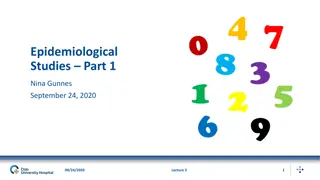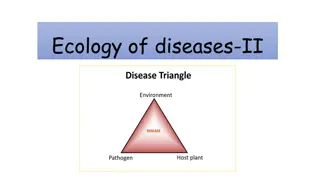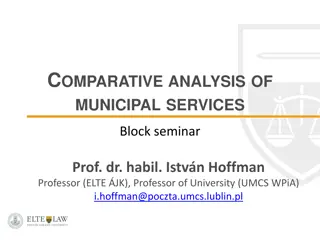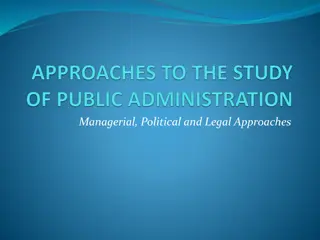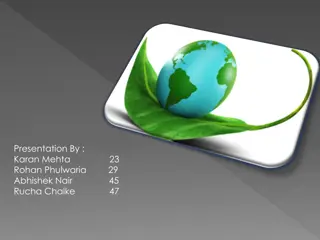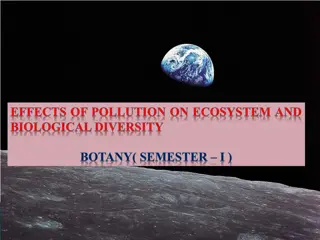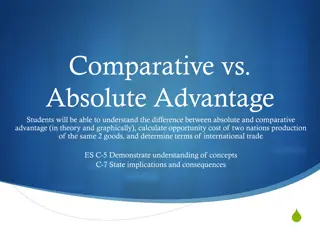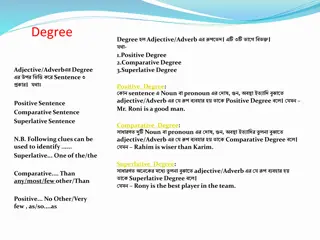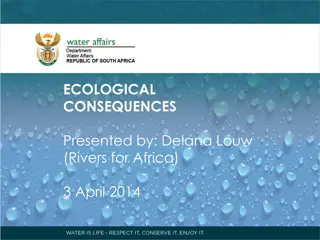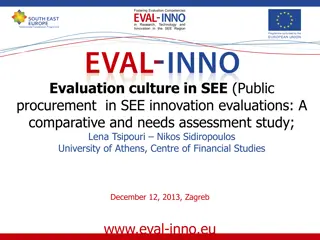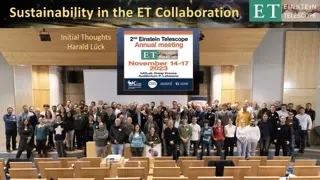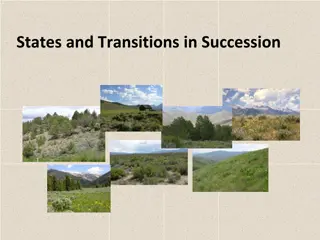The Ecological Approach in Comparative Public Administration
Fred W. Riggs, a proponent of the Ecological Approach in Public Administration, emphasized the importance of understanding the interaction between administrative systems and their external surroundings. He introduced the Fused-Prismatic-Diffracted Model to explore the unique contexts of developing countries and the impact of ecology on administrative structures. Riggs highlighted the shift from normative to empirical approaches, ideographic to nomothetic approaches, and non-ecological to ecological perspectives in Comparative Public Administration. His work focused on studying administrative dynamics within an ecological framework, influenced by scholars like J.M. Gaus and Robert A. Merton.
Download Presentation

Please find below an Image/Link to download the presentation.
The content on the website is provided AS IS for your information and personal use only. It may not be sold, licensed, or shared on other websites without obtaining consent from the author.If you encounter any issues during the download, it is possible that the publisher has removed the file from their server.
You are allowed to download the files provided on this website for personal or commercial use, subject to the condition that they are used lawfully. All files are the property of their respective owners.
The content on the website is provided AS IS for your information and personal use only. It may not be sold, licensed, or shared on other websites without obtaining consent from the author.
E N D
Presentation Transcript
By- Rakesh Ranjan Dept. of political Science, Patna University, Patna
Fred W. Riggs is propounder of Ecological Approach in Public Administration. He wrote the book The Ecology of Public Administration in 1962 in which he threw light on the relationship & interaction of an administration with its external surroundings. Riggs was well known for his studies in Comparative Public Administration specially Fused-Prismatic-Diffracted Model . He developed the model for understanding the administrative structures and organizational behaviour. The main thrust of his model is that Western Models are relatively less relevant to the developing countries, which have unique environment/contexts- social structures, economic life, cultural practices, political symbols, allocation of power, division of labour, etc. Unlike the developed nations, the administrative systems in these countries are considerably shaped by the ecology.
In the study of Comparative Public Administration, Riggs identified three major trends- (A) the shift form a Normative Approach to a more Empirical Approach, (B) the transformation from Ideographic Approach ( studies of a single agency or country) to a Nomothetic Approach ( giving greater priority to generalizations, laws and theory building based on regular patterns of administrative institution) and (C) the shift from a Non-ecological approach ( study of formal administrative institutions without considering contextual influence ) to a more Ecological Approach ( that emphasis on interaction between institutions and their contextual factors such as social structure, tradition, culture ). Riggs emphasized the need to study administrative systems in the ecological perspective so as to gain a comprehensive and in-depth understanding of the administrative dynamics.
The Ecological Approach to the study of public administration was first initiated by J. M Gaus, Robert Dhal and Robert A. Merton. Latter Riggs made distinctive contribution to the approach. Ecology of public administration includes the study of people place/property; physical and social technology; personality and aspirations of people; emergency conditions/ catastrophes. Gaus argued that administrative systems are influenced by its surrounding factors. Furthering this concept, Riggs analyzed the relationship between administrative systems and ecological factors- history, social structures, traditions, customs, economic situation, political symbols, technology and communication, etc, in a larger perspective. On the basis of his studies in Thailand and Philippines, he explained how environmental conditions influence administrative systems.
Riggs analysis of public administration primarily relies upon a Structural- Functional Approach. He refers to structure as a society s pattern of activity. Riggs attempted to explain the various societies. The traditional agrarian societies, highly developed industrial societies, and developing societies are functionally and structurally distinct. He termed functionally diffused societies as Fused societies (in traditional societies various social functions and social structures are highly functionally diffuse, that is, there is no organized division of labour) and functionally specific s societies are Diffracted societies (as found with in an industrialized societies). In addition to these two diametrically opposed extremes i.e. lack of division of labour society versus a highly specific s society, there is a third society called prismatic society - Riggs most popular model. Riggs emphasized that Fused-Prismatic-Diffracted models are designed to be ideal types not to be found in any actual society. Nevertheless these models would help us to understand and analyze the societies and function of administrative systems.
The ideal models of fused, prismatic and diffracted societies aimed at studying the prehistoric, developing and developed societies. While explaining the concept of structural- functional approach, it was mentioned that social structures may perform large no of functions in some societies. This is called multi-functionality and such social structures are called functionally diffuse . On the other hand functionally specific social structures perform only prescribed limited functions. Riggs calls functionally diffuse societies as Fused and the functionally specific societies as Diffracted . The society which is intermediate between these types of societies is called Prismatic" society. Prismatic society has features of both fused and diffracted societies. Riggs emphasized that all societies are generally prismatic and no society could be called purely fused or diffracted. It should be noted that Riggs developed fused-prismatic-diffracted models only for heuristic purposes and their exact characteristics are not found in any actual society.
Based on experiences in imperial China and pre-revolutionary Thailand, Riggs proposed the concept and characteristics of fused societies: (i) In these societies, a single structure carries out a number of functions. (ii)These societies heavily depend on agriculture with no industrialization and modernization. (iii) The economic system is based on law of exchange and barter system. (iv) The King and royal family members and officials nominated by the king carry out all administrative, economic and other activities by themselves.
Riggs maintained that the administrative systems in fused societies are based on the structure of family, and it strives to protect the special interests of the family and certain sects rather than aiming at universal happiness and overall development. These societies do not differentiate between justice and injustice; formal and informal setups and governmental and nongovernmental activities. Ascriptive values play a dominant role in the society and the behaviour of people are highly traditional. Age old customs, beliefs, faith and traditional ways of living enable people to live together and control their behaviours.
Riggs uses American society as a model of diffracted society. According to him characteristics of diffracted societies are: (i) Diffracted society is with a high degree of specialization and each structure carries out a specialized function. (ii) All organizations and structures in the society are created and based on scientific rational. (iii) Ascriptive values cease to exist, giving way to the attainment of values in the society. (iv) Governments are responsive to the needs of people and protection of human rights. People bring pressure on the government to get their demands fulfilled. (v) There is general consensus among the people on all basic aspects of social life. (vi) The economic system of this type of society is centered on market mechanism. The influence of market has both direct and indirect effects on the other facets of the society. Riggs described this as marketised society.
Riggs devoted much of his efforts on Prismatic Model to explain the nature and administration in the post-colonial emergent nations. While doing his field work in Thailand and teaching in Philippines, he articulated prismatic model based on the metaphor of prism as the fused white sunlight passes through a prism, it becomes diffracted into several separate colours. Here the fused light signifies fused structures of a traditional society; the diffracted colours represent the specialized or diffracted structures of modern society ; and the situation within the prism reflects the conditions in developing nations, which Riggs regarded as prismatic societies.
According to Riggs, prismatic society has three important characteristics, which are: (i) Heterogeneity: There exists modern features of society side by side with traditional features. The people are not integrated but divided on line of religion etc. Un equal level of development. Highly westernized and modern urban sector co-exists with rural irrational sector.
(ii) Formalism: Formalism is the deference between the prescribed and the practiced. Level of formalism is dependent on the nature of pressure for development. If the pressure comes from outside, level of formalism increases. In Formalistic situation, values and norms may receive lip service but ignored in real practice.
(iii) Functional overlapping : In a prismatic society similar functions are performed by different institutions. This features shows that differentiated structures co-exist with undifferentiated structures. Overlapping is manifest in a prismatic society by many features e. g. nepotism, poly-communalism or poly - normavativism, lack of consensus, separation of authority and control. Due to these features, the social change in a prismatic society is inconsistent, incomplete and irresponsive.
Riggs termed the administrative systems in prismatic societies as sala , which has variety of meanings; in diffracted societies it is known as such as bureau or office and in fused society it is termed as chamber. The sala has certain features of diffracted bureau and fused chamber. The administrative rationality and efficiency found in bureau are absent in the sala. Riggs explained that in the prismatic societies, family, community, nepotism etc., play important role in the appointment to various administrative positions and in taking decisions or performing administrative functions.
Characteristics: (i) Nepotism: In contrast to the diffracted society, in prismatic society the considerations of caste, religion, family and loyalty etc. are the deciding factors in official recruitment. In diffracted society universalism is the criteria for official recruitment. This is due to the fact that in prismatic society selectivism which is intermediate between universalism and particularism prevails i. e. sometimes universalism is followed while at others particularism is followed.
(ii) Poly-Communalism: Poly-communalism refers to the simultaneous existence in a society of various ethnic, religious and racial groups which remain quite hostile to each other while in existence. These groups are termed as clects by Riggs and they are characterized by attainment norms, selectivism and poly-functionalism. (iii) Poly-Normativism (Lack of consensus): This means that the traditional behaviour pattern co-exists with new sets of norms. This results in lack of consensus on norms of behaviour. Sala officials though publicly claim to follow objective, universalistic and achievement oriented norms actually follow subjective, particularistic and ascriptive behaviour .
(iv) Separation of Authority and Control: In a prismatic society the authority and control structures are separated. There is a separation of de-jure authority (legitimate power) from de-facto control (illegitimate power). The upper hand of bureaucrats in the exercise of power makes the political process weak and the administration becomes unresponsive in prismatic societies. This results in nepotism in recruitment, corruption and inefficiency in the administration of laws. (v) Bazaar-Canteen Model: Economic sub-system of prismatic society was termed as bazaar canteen by Riggs. In prismatic societies the prices charged for the public services vary according to the relationship between the sala official and his clientele.
(1) Critique of Riggs theory identifies the scope of the fused-prismatic-diffracted model as being too broad and abstract. Riggs structural -function studies, which include several cultural factors including economic, social, and political - are difficult to follow. (2) Scholars have found that in some cases the fused- prismatic-diffracted model ignores certain variables. For example, factors such as historical background, the political structure of post-colonial countries, territorial size, the status of hierarchical power, and the role of the military, as well as social ideologies were left out. (3) Riggs uses American society as his model of a diffracted society. Although American society is developed and industrialized but, it is wrong to infer that it is free of formalism and no longer a prismatic society.
(4) Another critique of the fused-prismatic- diffracted model argues that while it is predicated on the notion of deduction, there is little empirical evidence to support it. (5) Riggs has considered the impact of external socio-cultural, economic and political factors on sala but he has not much considered the impact of sala on socio-cultural and economic factors. (6) Riggsian models do not look into possibility of relative independence of various social structures .
The ideal type models of Riggs have influenced much research in Comparative Public Administration. Ecological models help qualitative comparisons among various societies. The ecological model has brought consciousness of interaction between administrative system and the social environment around it. It enables comparative public administration scholars to comprehend each country s administrative attributes and differences. The model has also to a great extent explained the problems of inefficiency in developing countries of the world.




